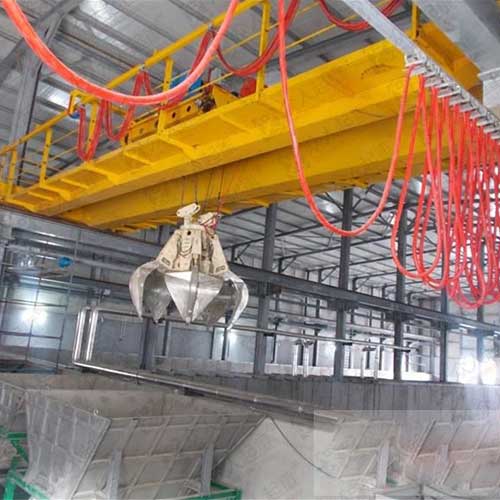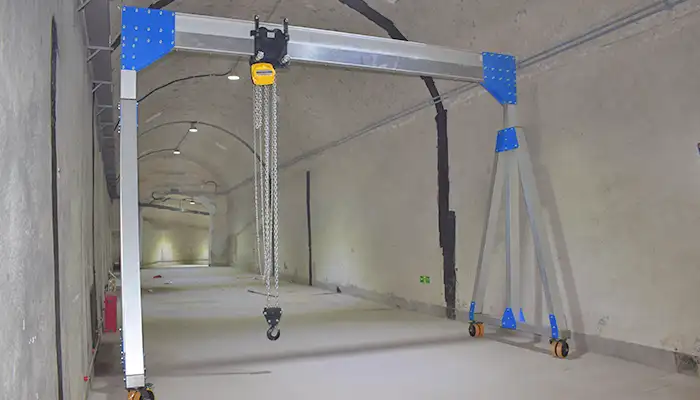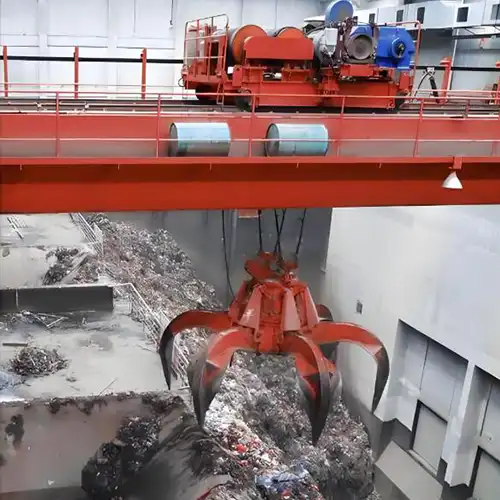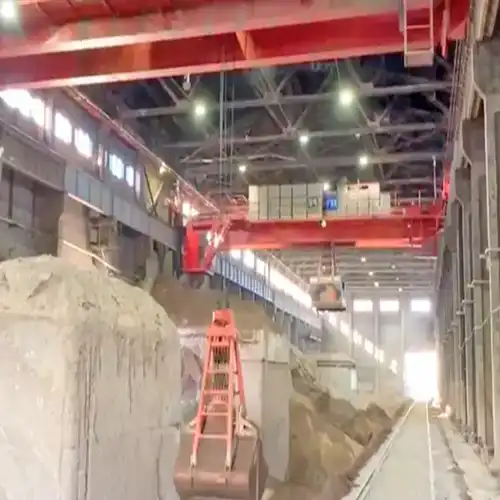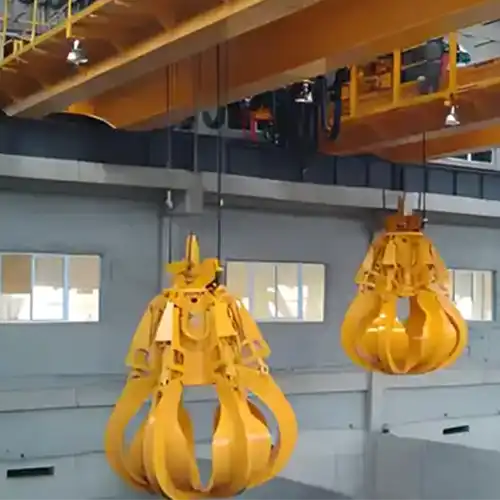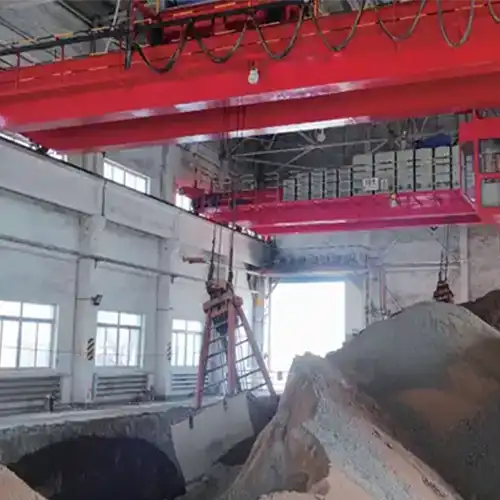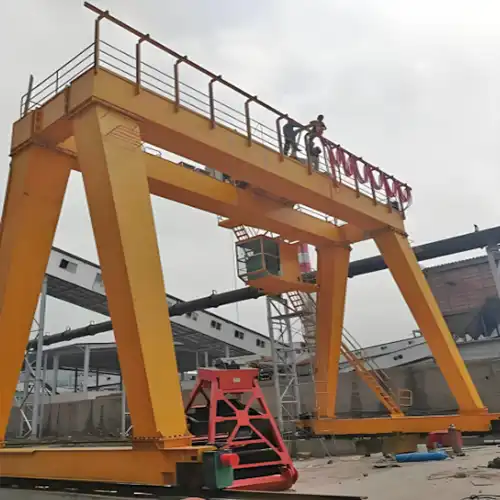Overehead Orange Peel Grab Bucket Crane for Energy Recycling 5 Ton -32 Ton
Orange peel grab bucket crane for sale 5 ton to 32 ton. Grab bucket crane with double girder overhead crane design for waste handling in energy recycling.
| Crane type | Grab bucket crane |
| Crane capacity | 5 ton -32 ton |
| Crane span | As your request |
| Lifting height | As customer requirement |
| Note | Customized as your requirements |
Category: Grab Crane
Your Trusted Grab Bucket Eot Crane Manufacturer & Supplier
Orange Peel Grab Bucket Crane for Energy Recycling 5 Ton -32 Ton
Orange Peel Grab Bucket Crane for Energy Recycling 5 Ton -32 Ton . Orange peel grab bucket crane for sale 5 ton to 32 ton. Grab bucket crane with double girder overhead crane design for waste handling in energy recycling.

Overhead Grab Bucket Crane Series
- Capacity: 5 ton -32 ton
- Lift height: 20-26 m or customized
- Span: 10.5-31.5m
- Work Duty: M8
- Protection class: IP65
- Working temperature: -10~+55 Degree
Benefits of Using Grab Bucket Cranes in Energy Recycling:
- - Efficient Material Handling: Grab bucket cranes ensure a steady supply of waste materials to energy conversion processes, optimizing energy production.
- - Resource Utilization: The cranes contribute to the recovery of energy from waste materials that would otherwise be disposed of in landfills.
- - Reduced Environmental Impact: By converting waste into energy, these facilities mitigate the environmental impact of waste disposal and reduce greenhouse gas emissions.
- - Reliable Operations: Grab bucket cranes are built for durability, enabling reliable performance in the demanding environment of waste-to-energy plants.
In the context of energy recycling, grab bucket cranes serve as essential tools for streamlining operations, promoting sustainable practices, and contributing to the generation of clean energy from waste materials.

Crane-1 Duty:
- - Handling freshly mixed Municipal Solid Waste (MSW) from heaps formed in the pit by tipping vehicles.
- - Transporting MSW from the unloading area to storage heaps within the pit.
- - Transferring partially dried MSW from storage heaps to hoppers for processing and segregation.

Crane-2 Duty:
- - Managing processed MSW and Refuse Derived Fuel (RDF) from heaps in the pit using a tipper conveyor. Spreading the RDF/MSW for storage in the RDF storage pit.
- - Moving RDF/MSW from storage heaps to hoppers for feeding the boiler.
Features of grab bucket crane for waste handling and energy recycling
The cranes operate continuously 24 hours a day, operating under the A8 extra heavy-duty classification, tailored to the practical operational conditions. Featuring a human-centric design and corrosion-resistant features, these cranes are suitable for the demanding and often dusty, high-humidity environments of waste stations. Their estimated service life is a minimum of 30 years.
The grab bucket cranes incorporate either fully automated or semi-automated controls within the energy-to-power plant. Operators manage operations from a fixed control room, employing PLC and HMI systems. Utilizing the touch screen interface, operators can perform tasks such as automatic grabbing, repetitive feeding and stacking, and fault diagnosis. The cranes offer features like large lifting height anti-sway, real-time dynamic measurement, programmable control of grab opening and closing, fault diagnosis alarms, and remote fault diagnosis functions.
Key Components:
- - Bridge section: Comprising main girders, end carriages, walkway platforms, sliding frames, etc.
- - Cross traveling (Trolley): Including the trolley frame, lifting motor, reducer, brake, drum, cable drum, etc.
- - Cross travel and long travel mechanisms: Incorporating driving and running wheel sets, buffer devices, etc.
- - Multi-petals Electric Hydraulic Grabs
- - CCTV cameras
- - Operating control stations
- - Intelligent electric control system: Encompassing a weighing system, control system, anti-sway system, safety protection system, featuring components like inverters, Siemens touch screen, PLC, HMI, and more.
- resistance.
Energy recycling grab bucket cranes stand at the core of the municipal solid waste incineration plant's garbage feeding system. Positioned above the garbage storage pit, two identical grab bucket cranes are typically installed for pivotal tasks in the energy recycling process. These tasks encompass feeding the boiler, mixing, stacking, moving, weighing, and stirring, ensuring an even distribution of garbage materials into the boiler. The roles of the two cranes are defined as follows:
Noteworthy Features:
- - Implementation of cutting-edge anti-swing control technology.
- - Integration of advanced and precise positioning technology.
- - Weighing management and communication technology.
- - Control technology for hydraulic grab lifting during grasping.
- - Fault self-diagnosis, remote monitoring, and upgrade technology.
- - Intelligent garbage level height judgment technology for full automation.
- - Utilization of vector frequency control technology, Siemens PLC control technology, CMS intelligent remote service management system for real-time monitoring.
These cranes demand high-performance cables with attributes like wear resistance, oil resistance, cold resistance, tensile strength, torsion resistance, hydrolysis resistance, and corrosion resistance.
Energy recycling grab bucket cranes are the epitome of technology, efficiency, and sustainability, revolutionizing the conversion of waste into valuable energy resources.
Industrial grab bucket cranes & hoists systems for energy industry
With one-stop crane services, we have offered tailored electric overhead travelling crane solutions to many energy generation plants and factories world widely for material handling during the installation production, operation and maintenance.
As one of the best crane manufactuer and supplier in China, we offer crane sevices for turnkey crane projects ie.overhead, gantry & jib cranes and other travelling cranes from crane degin, manufactuering & installation, and crane parts supplying, etc.
Grab bucket cranes used in energy recycling, often referred to as waste-to-energy facilities or resource recovery plants, play a crucial role in the conversion of waste materials into energy. These cranes facilitate the efficient handling and transport of various waste materials, such as municipal solid waste (MSW) and biomass, to be processed and converted into energy through methods like incineration or anaerobic digestion. Here's how grab bucket cranes are utilized in energy recycling:
- 1. Waste Handling and Feeding: - Grab bucket cranes are employed to unload, handle, and feed waste materials into the energy recovery process. They efficiently load waste materials into hoppers or feed systems that lead to combustion chambers or other treatment units.
- 2. Loading and Mixing of Biomass: - Biomass, including organic waste and agricultural residues, can be converted into bioenergy through anaerobic digestion or combustion. Grab bucket cranes are used to load and mix these biomass materials, ensuring proper blending for efficient energy production.
- 3. Feeding Incineration Units: - In waste-to-energy plants, waste materials are incinerated to generate heat, which is then converted into electricity or heat energy. Grab bucket cranes handle the delivery of waste to incineration units, ensuring a steady supply for the combustion process.
- 4. Ash Handling and Disposal: - After waste is incinerated, ash is left behind. Grab bucket cranes are employed to handle and transport the ash residue to storage areas or further processing for safe disposal or recovery of valuable materials.
- 5. Resource Recovery: - Some energy recycling facilities focus on recovering valuable materials from waste streams before energy conversion. Grab bucket cranes help separate recyclables from mixed waste, contributing to both energy production and recycling efforts.
- 6. Biomass Storage and Management: - Grab bucket cranes are utilized for the loading, unloading, and transport of biomass materials, such as wood chips, agricultural residues, and other organic materials, for use in bioenergy production.
Buyer Guider to Waste Handling Grab Bucket Cranes
This comprehensive buyer's guide aims to provide potential buyers with a structured approach to selecting the most suitable waste handling grab bucket crane for their specific needs and operational requirements. Each section covers essential considerations to ensure a well-informed decision-making process.
In a world grappling with environmental challenges, efficient waste management has become a critical priority. The responsible handling, treatment, and disposal of waste materials not only mitigate environmental impact but also pave the way for sustainable resource utilization. At the heart of this transformative endeavor are waste handling grab bucket cranes – robust and versatile machines designed to revolutionize the way waste is managed. In this comprehensive guide, we delve into the key facets of waste handling grab bucket cranes, shedding light on their significance and contributions to modern waste management practices.
Understanding the Importance of Efficient Waste Handling
Waste management is no longer a mere necessity; it's an ethical obligation. The sheer volume of waste generated globally necessitates innovative solutions that go beyond traditional disposal methods. Efficient waste handling is paramount to minimize pollution, reduce strain on landfills, and conserve valuable resources. Proper waste management not only prevents environmental degradation but also ensures public health and safety.
Role of Grab Bucket Cranes in Waste Management
Enter grab bucket cranes – the technological marvels that have redefined waste management. These cranes play a pivotal role in various waste handling processes, from collection and transportation to processing and disposal. Their ability to lift, transport, and deposit waste materials with precision and efficiency has revolutionized waste management practices across industries.
Key Considerations Before Buying a Waste Handling Grab Bucket Crane
Before embarking on the journey to acquire a waste handling grab bucket crane, it's essential to navigate a spectrum of crucial considerations. Each facet contributes to the seamless integration of these cranes into waste management systems while ensuring optimal performance and compliance with regulations.
Identifying Specific Waste Handling Needs
No two waste management scenarios are alike. Before choosing a grab bucket crane, identify the types of waste materials you'll be handling, the volume generated, and the frequency of operations. Whether it's municipal solid waste (MSW), industrial waste, or recycling materials, a clear understanding of your waste profile lays the foundation for selecting the right crane.
Understanding Site and Operational Requirements
Consider the spatial limitations of your waste management facility. Evaluate factors such as available space for crane installation, accessibility, and proximity to waste generation points. The crane's maneuverability and lifting capacity should align with the operational demands of your facility.
Budgeting and Cost Considerations
Waste handling grab bucket cranes represent a significant investment. As such, budget considerations are paramount. While it's essential to optimize costs, focus on the long-term value the crane brings to your waste management operations. Factor in maintenance, operational efficiency, and potential cost savings achieved through streamlined waste handling processes.
Safety and Environmental Regulations
Waste management operations are subject to stringent safety and environmental regulations. Ensure that the chosen crane complies with these standards to safeguard worker well-being, prevent accidents, and minimize environmental impact. Features such as overload protection systems, anti-collision devices, and emission controls contribute to a safe and sustainable waste management environment.
By navigating these key considerations, you lay the groundwork for a well-informed decision in acquiring a waste handling grab bucket crane. In the subsequent sections of this guide, we will delve deeper into the technical aspects of these cranes, ensuring that you are equipped with the knowledge needed to make a transformative choice in waste management practices.
Key Considerations Before Buying a Waste Handling Grab Bucket Crane
Efficient waste handling is not just a necessity but a responsibility that resonates with environmental sustainability. As waste volumes escalate globally, the role of waste handling grab bucket cranes becomes pivotal in redefining waste management practices. However, before delving into the acquisition process, a thorough understanding of critical considerations is essential to ensure the selection of the most suitable crane for your waste management operations.
Identifying Specific Waste Handling Needs
Waste materials are diverse, ranging from municipal solid waste (MSW) to industrial byproducts and recyclables. To select the right grab bucket crane, it's imperative to ascertain the specific types of waste you will be managing. The crane's capabilities should align with the weight, size, and characteristics of the waste materials. Whether you're dealing with compacted MSW or bulky recycling materials, tailoring the crane's specifications to match your waste profile is crucial.
Understanding Site and Operational Requirements
The physical layout of your waste management facility plays a significant role in determining the optimal crane design. Consider factors such as available space, layout constraints, and accessibility. The crane's maneuverability must seamlessly integrate with the facility's operational flow, ensuring efficient waste handling processes. Assess the crane's lifting capacity in relation to the distance it needs to cover, optimizing both space utilization and operational efficiency.
Budgeting and Cost Considerations
Investing in waste handling grab bucket cranes represents a commitment to improved waste management practices. While budget considerations are important, focus on the broader value proposition. A crane's cost extends beyond the initial purchase price to factors such as maintenance, operational efficiency gains, and potential cost savings through streamlined waste handling. Striking a balance between upfront costs and long-term benefits is key to a prudent investment.
Safety and Environmental Regulations
Waste management operations are subject to stringent safety and environmental regulations. When evaluating potential cranes, prioritize models equipped with safety features that adhere to industry standards. Overload protection systems, anti-collision devices, emergency stop mechanisms, and emission controls contribute to a secure working environment for operators and compliance with environmental norms. A crane that meets or exceeds these regulations not only enhances safety but also ensures responsible waste handling practices.
By meticulously navigating these key considerations, you lay the groundwork for a well-informed decision in acquiring a waste handling grab bucket crane that aligns with your waste management goals. The subsequent sections of this guide will delve deeper into the technical intricacies of these cranes, empowering you with the knowledge needed to make a transformative impact in waste management efficiency and sustainability.
Types of Grab Bucket Cranes for Waste Handling
When it comes to waste handling, the efficiency and effectiveness of your operations largely depend on choosing the right type of grab bucket crane. Waste materials vary in size, density, and characteristics, and selecting the appropriate crane type can significantly impact your waste management processes. In this section, we explore the diverse options available and provide insights into making an informed decision.
Different Types of Grab Mechanisms (Clamshell, Orange Peel, etc.)
Grab bucket cranes are equipped with various grab mechanisms designed to match the specific attributes of waste materials. Common grab types include clamshell and orange peel grabs. Clamshell grabs are ideal for loose and bulk materials, while orange peel grabs excel in handling irregularly shaped or granular waste. Understanding the nature of your waste stream will guide you in selecting the most suitable grab mechanism.
Single Girder vs. Double Girder Cranes
The structural design of the crane is another critical aspect to consider. Single girder cranes feature one horizontal beam, offering cost-efficiency and optimal use of space. Double girder cranes, with two horizontal beams, provide increased lifting capacity and higher durability. Your choice depends on the volume and weight of waste materials being handled, as well as the available space in your waste management facility.
Determining the Suitable Crane Type for Waste Materials
Selecting the right grab bucket crane type involves a comprehensive assessment of your waste materials. If your waste stream primarily consists of large, bulky items, a heavy-duty grab mechanism and a double girder crane might be more suitable. Conversely, for lighter or granular waste materials, a single girder crane with a grab mechanism tailored to the waste profile may suffice. Matching the crane's capabilities with your waste characteristics enhances operational efficiency and waste handling accuracy.
Hoist & Cranes for General Use
0.25 ton to 550 ton overhead cranes for wide industrial applications. Types of overhead cranes with different crane configuration, ie, Top running overhead cranes , Under hung or overhead cranes, and free standing overhead KBK cranes, with various crane bridge girder designs, including single girder, double girder ,box girder, Beam girder, monorails, etc., are manufactured and supplied for industrial material handling in various workshops and workstations, etc.

Single girder overhead crane
Single girder overhead crane designs, various single girder crane hoists, economical single girder overhead crane price, ideal overhead travelling crane solution.

Double girder overhead crane
Double girder overhead cranes -overhead travelling hoist crane & open winch crane - with below the hook lifting devices, grab, magnet, spreader,C hook, etc.

FEN standard open winch crane
FEM/ DIN open winch bridge crane-European standard double girder overhead crane with open winch trolley, your heavy duty winch crane up to 320 ton.

European style single girder overhead crane
European standard overhead hoist crane,single girder overhead cranes, compact FEM hoist crane design, small & light overhead hoist crane.

Suspension Crane & Underhung Overhead crane
Double/ single girder suspension cranes, ceiling mounted crane system, economical underslung bridge crane solution. Get free Suspension crane design for your ceiling now.

Light duty KBK crane & Workstation Crane
kbk light crane systems, flexible kbk crane & rigid kbk crane, modular crane design, cost-effective workstation crane solution, tailored light duty bridge crane.

Electric chain hoist
Electric chain hoists mounted on hook, lug, manual or electric hoist trolley for types of electric chain hoist cranes with capacity of 500kg, 5 ton, 10 ton, 32 ton.

Electric wire rope hoist
Types of wire rope hoists designs for overhead hoist cranes- explosion-proof cable hoist, low profile wire hoist & single & double girder hoists for your hoist cranes.

Air Hoist & Pneumatic Hoist
Safe & fast air operated hoists. Air hoist & pneumatic hoist is a compressed air powered hoist & air operated hoists,wide specification, good price.

Double girder gantry crane
Double girder gantry crane specifications: Capacity: 5 ton - 500 ton, Span Length: 12~35m, Working Class: A5, A6.Ask for double girder gantry crane price.

Single girder gantry crane
Single girder gantry crane specifications: Capacity: 1ton-20ton, Span Length: 8~30m, Working Class: A3, A4. Ask for single girder gantry crane price.

Singl Leg Semi Gantry Crane
Semi gantry crane designs, single leg gantry cranes, save half gantry crane cost with existing workshop.Semi gantry cranes & semi goliath cranes for sale.

Floor mounted slewing jib crane
Free standing jib crane-Pillar mounted jib crane is a free standing jib crane with pillar jib mounted on floor, for short & crowded lifting, capacity up to 16 ton.

Wall mounted jib crane
Wall mounted jib crane & wall bracket jib crane with I beam & tie rod design for light duty handling with capacity up 2 ton. or less building structure changes.

Wall travelling jib crane
Wall travelling jib crane, a perfect & economical cantilever wall travelling crane for light & long distance lifting. Wall travelling jib crane, your efficient light duty crane!

Movable & Portable Jib Crane
Portable jib crane on wheels/ rollers, self-supportive jib mobile crane design, no foundation, wide application. Mobile jib crane & Movable jib crane for sale, economical & profitable.
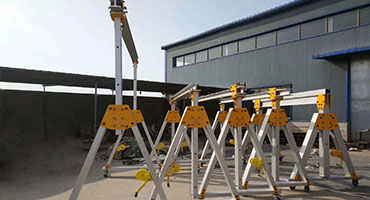
Aluminium gantry cranes
500kg -10 ton fixed gantry crane, a type of aluminum gantry crane with stationary design, with no rail & castors. Light, Foldable, Easy use & Assembly.

Light Crane or Small Crane
Light Crane System Small, Portable & Economical,i.e.,lightweight overhead crane system,lightweight gantry crane,light duty jib crane for all you needs.
Factors to Consider:
- 1. Waste Characteristics: Analyze the size, weight, and nature of your waste materials to determine the appropriate grab mechanism.
- 2. Operational Intensity: Consider the frequency and volume of waste handling operations to ensure the crane can meet your operational demands.
- 3. Space Constraints: Evaluate the available space in your waste management facility to choose between single and double girder crane options.
- 4. Future Expansion: Anticipate changes in waste volume and types over time to select a crane that can accommodate potential growth.
- 5. Budget: Balancing your budget with the crane's capabilities is crucial. Opt for a crane that offers the best value while meeting your waste handling requirements.
Choosing the right grab bucket crane type for waste handling requires a strategic evaluation of your waste profile, operational needs, and facility constraints. By aligning the crane's features with the specific attributes of your waste materials, you optimize waste management processes and set the stage for efficient, sustainable operations. The subsequent sections of this guide will delve deeper into other pivotal considerations on your journey toward selecting the ideal waste handling grab bucket crane.
Capacity and Load Requirements
In the realm of waste handling, efficiency is paramount, and one of the cornerstones of efficiency is the proper matching of a grab bucket crane's capacity with the waste materials it will handle. In this section, we delve into the crucial aspects of assessing lifting capacity, aligning it with waste volume, and accounting for future growth.
Calculating Required Lifting Capacity
The lifting capacity of a grab bucket crane directly impacts its performance. To determine the appropriate capacity, it's imperative to calculate the maximum weight of the waste materials you intend to lift. Consider the heaviest loads you anticipate handling regularly, factoring in safety margins. Keep in mind that grabbing mechanisms can add significant weight, so include the grab's weight in your calculations.
Matching Crane Capacity with Waste Volume
A crane's lifting capacity should harmonize with the volume of waste materials being handled. High waste volume demands a crane capable of lifting heavier loads, ensuring efficient waste management without causing strain on the equipment. Conversely, a crane with excessive capacity for low waste volumes might result in inefficient operations. Achieving the right balance ensures optimal use of the crane's capabilities.
Considering Future Growth in Waste Generation
The waste management landscape is dynamic, with waste volumes evolving over time. When selecting a crane, think beyond your current waste generation levels. Anticipate potential growth in waste volume due to population increases or changes in waste profiles. Investing in a crane with slightly higher capacity than your present needs can accommodate future growth without the need for premature equipment replacement.
Factors to Consider:
- 1. Waste Types: Different waste materials have varying densities. Ensure your crane's capacity accounts for the heaviest waste types you'll handle.
- 2. Grab Weight: Remember to include the weight of the grab mechanism when calculating lifting capacity.
- 3. Average Load: Analyze the average weight of waste materials to choose a capacity that aligns with your operational demands.
- 4. Safety Margin: Incorporate a safety margin into your calculations to prevent overloading and ensure crane longevity.
- 5. Future Expansion: Plan for potential increases in waste volume by selecting a crane with capacity headroom.
By accurately assessing your waste handling needs and projecting future growth, you ensure that your chosen grab bucket crane can handle the demands of your operations seamlessly. Investing in a crane with the right lifting capacity optimizes performance, reduces downtime, and enhances overall waste management efficiency. As we proceed through this guide, you'll gain deeper insights into additional considerations essential for making an informed decision in acquiring a waste handling grab bucket crane.
Durability and Construction
In the realm of waste handling, durability is non-negotiable. A grab bucket crane that can withstand the rigors of continuous operation in demanding environments is an asset that ensures uninterrupted waste management processes. In this section, we explore the critical considerations related to the durability and construction of waste handling grab bucket cranes.
Material Selection for Crane Components
The components of a grab bucket crane must be built to last. Optimal material selection enhances both the structural integrity and the performance of the crane. Key components such as main girders, end carriages, and grab mechanisms should be fabricated from high-quality materials that can withstand the stresses of lifting, transporting, and depositing heavy waste materials.
Corrosion Resistance for Harsh Environments
Waste management facilities often present challenging environments characterized by humidity, corrosive substances, and exposure to varying weather conditions. To ensure the crane's longevity, prioritize materials that offer exceptional corrosion resistance. This prevents premature wear, rust, and degradation, which can compromise the crane's performance and lifespan.
Lifespan and Longevity of the Crane
Investing in a grab bucket crane is a long-term commitment. Therefore, selecting a crane with a prolonged lifespan is essential to optimize your investment. Durability not only reduces maintenance costs but also ensures that the crane remains reliable and operational over many years. By choosing materials and construction techniques that withstand wear and tear, you contribute to the crane's extended service life.
Factors to Consider:
- 1. Material Properties: Choose materials with high tensile strength, fatigue resistance, and excellent load-bearing capacity for critical components.
- 2. Coatings and Finishes: Prioritize protective coatings and finishes that resist corrosion and environmental damage.
- 3. Maintenance Requirements: Assess the ease of maintenance for crane components. Components that are easily accessible and replaceable contribute to efficient maintenance practices.
- 4. Operating Conditions: Consider the specific environmental conditions of your waste management facility, such as humidity, chemicals, and temperature variations.
- 5. Vendor Reputation: Research the reputation of crane manufacturers in terms of construction quality and the materials they use.
By focusing on durability and construction, you ensure that your waste handling grab bucket crane can withstand the challenges posed by waste management environments. An investment in a well-constructed, corrosion-resistant crane translates to enhanced operational efficiency, reduced downtime, and long-term cost savings. As we move forward in this guide, we'll delve deeper into other pivotal considerations that guide your journey toward selecting the ideal waste handling grab bucket crane.
Safety Features and Standards
Safety is paramount in waste handling operations, where heavy loads and dynamic environments pose inherent risks. A waste handling grab bucket crane equipped with advanced safety features not only protects operators and personnel but also ensures smooth and secure waste management processes. In this section, we delve into the critical safety considerations when choosing a grab bucket crane for waste handling.
Overload Protection Systems
Waste handling operations involve lifting various weights of waste materials. An overload protection system is a crucial safety feature that prevents the crane from lifting loads beyond its safe capacity. This system detects excessive loads and triggers alerts or stops the operation to prevent damage to the crane and ensure operator safety.
Anti-Collision Devices
In facilities where multiple cranes operate in close proximity, the risk of collisions increases. Anti-collision devices are sensors and systems that prevent cranes from colliding with each other or with other structures. These devices enhance the safety of both the crane operators and the equipment itself.
Emergency Stop Mechanisms
Unforeseen circumstances can arise during waste handling operations that necessitate an immediate halt. Emergency stop mechanisms enable rapid cessation of crane movement in critical situations, minimizing the potential for accidents, injuries, and equipment damage.
Compliance with Industry Safety Standards
Waste handling operations are subject to stringent safety regulations and industry standards. When selecting a grab bucket crane, prioritize models that comply with these standards. These standards ensure that the crane design, safety features, and operation adhere to best practices, safeguarding workers, equipment, and the environment.
Factors to Consider:
- 1. Safety Features: Assess the presence of essential safety features such as overload protection, anti-collision systems, and emergency stop mechanisms.
- 2. Operator Training: Ensure that crane operators are well-trained to operate the crane safely and efficiently.
- 3. Maintenance Procedures: Incorporate safety considerations into maintenance procedures to maintain the crane's safety features.
- 4. Regulatory Compliance: Verify that the chosen crane adheres to industry safety standards and regulations.
- 5. Vendor Reputation: Research the reputation of crane manufacturers in terms of safety-focused designs and compliance.
By prioritizing safety features and adherence to industry standards, you create a secure work environment for waste handling operations. A crane equipped with advanced safety mechanisms not only mitigates risks but also boosts operator confidence and ensures consistent, accident-free waste management processes. As we progress in this guide, you'll gain insights into other crucial considerations that guide your selection of a waste handling grab bucket crane.
Customization Options
The diversity of waste materials and the unique operational demands of waste management facilities underscore the importance of customization in grab bucket cranes. A one-size-fits-all approach is rarely effective in waste handling operations. In this section, we delve into the significance of customization and the myriad options available to tailor a grab bucket crane to your specific waste management needs.
Tailoring the Crane for Specific Waste Handling Processes
Every waste management facility has distinct waste handling processes that require a crane to operate seamlessly within the workflow. Customization involves adapting the crane's specifications, such as lifting capacity, reach, and grab mechanism, to match your specific operational requirements. By fine-tuning the crane's features, you optimize its performance in handling your unique waste materials.
Integration of Additional Features (CCTV, Weighing Systems, etc.)
Modern waste handling cranes offer a range of additional features that enhance operational efficiency and safety. Closed-circuit television (CCTV) cameras provide enhanced visibility for crane operators, allowing them to monitor waste handling processes from the control room. Weighing systems accurately measure the weight of waste materials, aiding in precise load calculations. By integrating these features, you create a tailored solution that aligns with your facility's needs.
Adapting the Crane to Site Constraints
Waste management facilities often operate within spatial limitations. Customization allows you to adapt the crane to site-specific constraints, ensuring optimal space utilization and seamless integration into your facility's layout. Whether it's modifying the crane's dimensions or designing specialized components, customization ensures the crane aligns with your site's unique features.
Factors to Consider:
- 1. Operational Workflow: Analyze your waste handling processes and adapt the crane's features to optimize its role in your operations.
- 2. Additional Features: Consider the integration of features like CCTV cameras, weighing systems, and advanced control mechanisms to enhance efficiency.
- 3. Spatial Constraints: Evaluate your facility's layout and adapt the crane's dimensions and design to fit within site limitations.
- 4. Future Expansion: Plan for future growth by opting for a crane that can be easily modified or upgraded as your waste management needs evolve.
- 5. Vendor Expertise: Collaborate with crane manufacturers who specialize in customization and have a track record of tailoring solutions to unique requirements.
By customizing your grab bucket crane to align with your waste management processes, you optimize efficiency, safety, and overall operational performance. A crane that caters to your specific needs ensures that waste handling is streamlined and efficient, contributing to improved waste management practices. As we delve deeper into this guide, you'll gain insights into other vital considerations that shape your decision-making process in acquiring a waste handling grab bucket crane.
Maintenance and Service
The journey toward efficient waste management doesn't end with the acquisition of a grab bucket crane. To ensure the crane's consistent performance and longevity, a well-structured maintenance and service plan is crucial. In this section, we explore the pivotal aspects of maintenance and service that contribute to the seamless operation of your waste handling grab bucket crane.
Regular Maintenance Requirements
Like any sophisticated machinery, grab bucket cranes require regular maintenance to operate optimally. Develop a comprehensive maintenance schedule that includes routine inspections, lubrication, and addressing minor issues before they escalate. Regular maintenance not only enhances the crane's lifespan but also prevents downtime that can disrupt waste handling operations.
Availability of Spare Parts
Over time, components may wear out and require replacement. It's essential to partner with crane manufacturers who offer a readily available inventory of genuine spare parts. Easy access to spare parts streamlines maintenance activities, ensuring that the crane can be quickly brought back to operational status in case of breakdowns.
Support and Service from the Manufacturer
Choosing a reputable crane manufacturer ensures ongoing support and service throughout the crane's lifespan. A manufacturer with a strong track record in customer service can provide technical assistance, troubleshooting, and guidance on maintenance practices. Regular communication with the manufacturer's service team fosters a collaborative relationship that contributes to the crane's reliable performance.
Factors to Consider:
- 1. Maintenance Schedule: Develop a proactive maintenance schedule that covers routine inspections, lubrication, and preventive measures.
- 2. Spare Parts Inventory: Choose a manufacturer that offers a wide range of genuine spare parts readily available when needed.
- 3. Service Contracts: Consider service contracts or agreements with the manufacturer that outline the scope of support and maintenance services.
- 4. Technical Support: Partner with manufacturers known for their responsive and knowledgeable technical support teams.
- 5. Vendor Reputation: Research the manufacturer's reputation for after-sales service, maintenance support, and spare parts availability.
By prioritizing maintenance and service, you safeguard the continued performance of your grab bucket crane. An efficiently maintained crane not only contributes to waste management efficiency but also minimizes operational disruptions. As we progress in this guide, you'll gain insights into other essential considerations that contribute to your decision-making process when acquiring a waste handling grab bucket crane.
Operator Training and User-Friendly Controls
The efficiency and safety of waste handling operations heavily depend on the competence of crane operators and the user-friendliness of crane controls. In this section, we explore the significance of proper operator training and the essential features of user-friendly controls for waste handling grab bucket cranes.
Training Programs for Crane Operators -
Well-trained operators are the backbone of efficient waste handling. Crane manufacturers often offer training programs that familiarize operators with the crane's controls, safety protocols, and operational best practices. Adequate training ensures that operators can navigate waste handling processes seamlessly, minimizing the risk of accidents and errors.
Ease of Use and Intuitive Controls
Complex controls can lead to confusion and errors during waste handling operations. Opt for a crane with intuitive controls that are easy to understand and operate. User-friendly controls contribute to efficient waste handling, allowing operators to focus on the task at hand rather than grappling with complicated control interfaces.
Remote Control Options for Operator Convenience
Modern technology has enabled the integration of remote control options for grab bucket cranes. Remote controls enhance operator convenience, providing the flexibility to manage the crane's movements from a safe distance. This is particularly beneficial in situations where the crane operates in hazardous or challenging environments.
Factors to Consider:
- 1. Operator Training Programs: Choose a manufacturer that offers comprehensive training programs for crane operators to ensure safe and efficient operations.
- 2. Control Interface: Prioritize cranes with user-friendly and intuitive control interfaces that minimize the learning curve for operators.
- 3. Remote Control Features: If applicable, consider cranes equipped with remote control options for added convenience and safety.
- 4. Operator Feedback: Involve potential crane operators in the selection process to gather input on control preferences and ease of use.
- 5. Safety Measures: Ensure that the controls include safety features such as emergency stop mechanisms and anti-sway systems.
By prioritizing operator training and user-friendly controls, you create an environment where waste handling operations can be executed efficiently and safely. A well-trained operator with access to intuitive controls contributes to smooth waste management processes and minimizes the potential for accidents or errors. As we proceed in this guide, you'll gain insights into the final considerations that shape your decision-making process when acquiring a waste handling grab bucket crane.
Environmental Considerations
In an era of increased environmental consciousness, waste management practices are expected to align with sustainability goals. When selecting a waste handling grab bucket crane, considering its environmental impact is essential. In this section, we delve into the crucial environmental considerations that contribute to responsible waste handling operations.
Energy Efficiency of Crane Operation
Energy-efficient cranes contribute to reduced operational costs and a smaller carbon footprint. Opt for cranes designed with energy-efficient technologies, such as variable frequency drives and regenerative braking systems. These features not only save energy but also extend the crane's lifespan by reducing wear and tear on components.
Noise and Emission Levels
Waste management facilities often operate in proximity to residential areas or sensitive ecosystems. Choosing cranes with low noise and emission levels mitigates potential disruptions to neighboring communities and minimizes the impact on the environment. Quiet and environmentally friendly crane operation aligns with sustainable waste management practices.
Environmental Impact of Material Handling Practices
Waste handling involves the movement and manipulation of various materials, some of which can be hazardous to the environment if not managed properly. Consider how the crane's design and operation align with responsible material handling practices. Opt for features that prevent material spillage, leakage, and contamination to ensure that waste management processes are environmentally sound.
Factors to Consider:
- 1. Energy Efficiency Features: Look for cranes equipped with energy-saving technologies that contribute to efficient and sustainable operations.
- 2. Noise and Emission Levels: Prioritize cranes with reduced noise and emission levels to minimize environmental impact.
- 3. Material Containment: Consider features that prevent material spillage, leakage, and contamination during waste handling processes.
- 4. Sustainability Goals: Choose a crane that aligns with your facility's sustainability goals and commitment to responsible waste management.
- 5. Regulatory Compliance: Ensure that the crane's operation adheres to local environmental regulations and standards.
By incorporating environmental considerations into your decision-making process, you contribute to responsible waste handling practices that minimize the impact on the environment and surrounding communities. An environmentally conscious approach to crane selection aligns with modern sustainability values and ensures that your waste management facility operates in an eco-friendly manner. As we conclude this guide, you'll gain insights into the final aspects that shape your journey in acquiring a waste handling grab bucket crane.
How Different Industries Benefitted from Using Grab Bucket Cranes
Diverse industries, each with its unique waste management demands, have reaped significant benefits from adopting grab bucket cranes. By exploring the advantages experienced by these industries, you gain insights into how these cranes enhance operational efficiency, safety, and sustainability across sectors such as recycling, mining, construction, and more.
Factors to Consider:
- 1. Industry Relevance: Look for case studies that align with your facility's industry and waste management requirements.
- 2. Operational Challenges: Analyze the challenges faced by industries and how grab bucket cranes were instrumental in addressing those challenges.
- 3. Quantifiable Benefits: Assess the concrete benefits highlighted in the case studies, such as increased productivity, reduced costs, and enhanced safety.
- 4. Vendor Expertise: Consider the manufacturers behind these success stories and their reputation for delivering effective waste handling crane solutions.
- 5. Lessons Learned: Extract valuable insights and lessons from these case studies that can inform your crane selection and operational strategies.
By delving into case studies and success stories, you gain a deeper appreciation for the practical impact of waste handling grab bucket cranes. These real-world examples showcase the versatility and effectiveness of these cranes in improving waste management processes and outcomes. As you conclude your exploration of this guide, you are empowered with a comprehensive understanding of the role and benefits of waste handling grab bucket cranes across various industries.
Choosing the Right Manufacturer and Supplier
Selecting the right manufacturer and supplier is a pivotal step in acquiring a waste handling grab bucket crane that meets your needs and expectations. In this final section, we explore the crucial considerations for identifying a manufacturer that can deliver reliable, high-quality cranes for your waste management operations.
Researching Reputable Crane Manufacturers
Start your journey by researching well-established and reputable crane manufacturers. Look for manufacturers with a proven track record of delivering durable and efficient waste handling grab bucket cranes. A manufacturer's reputation in the industry is a strong indicator of their commitment to quality and customer satisfaction.
Reading Reviews and Getting Recommendations
Customer reviews and recommendations provide valuable insights into the experiences of other waste management professionals who have worked with the manufacturer. Online reviews and referrals from industry peers can offer an unbiased perspective on the manufacturer's product quality, customer service, and overall satisfaction.
Evaluating Manufacturer's Track Record and Expertise
Consider the manufacturer's experience and expertise in designing and producing waste handling grab bucket cranes. A manufacturer with a history of successfully catering to diverse industries and solving complex waste management challenges demonstrates their ability to deliver customized and effective solutions.
Factors to Consider:
- 1. Reputation: Research manufacturers with a positive reputation for producing high-quality and reliable waste handling grab bucket cranes.
- 2. Customer Feedback: Read reviews and seek recommendations from other professionals in the waste management industry to gauge customer satisfaction.
- 3. Industry Expertise: Evaluate the manufacturer's experience in waste management and their understanding of industry-specific requirements.
- 4. Customization Capabilities: Choose a manufacturer that can tailor crane solutions to your unique waste handling processes and needs.
- 5. Technical Support: Prioritize manufacturers that offer responsive technical support, maintenance services, and spare parts availability.
By thoroughly researching and evaluating crane manufacturers, you ensure that your waste handling grab bucket crane is sourced from a trusted partner who can deliver a solution that aligns with your operational goals. A manufacturer with a strong reputation, proven expertise, and a history of satisfied customers can make a significant difference in your waste management operations. As you conclude your journey through this guide, you are well-equipped to make an informed decision in choosing the right manufacturer and supplier for your waste handling grab bucket crane.
Requesting Quotes and Evaluating Proposals
Once you have identified potential manufacturers for your waste handling grab bucket crane, the next crucial step is to request quotes and evaluate proposals. In this section, we delve into the essential considerations for making a well-informed decision when comparing quotes and assessing the value of the crane solutions offered.
Comparing Quotes from Different Manufacturers
Reach out to the manufacturers on your list and request detailed quotes for the waste handling grab bucket crane. While price is an important factor, it's not the only consideration. Review the quotes holistically to understand what each manufacturer is offering in terms of crane specifications, features, warranty, and services.
Analyzing Technical Specifications and Features
Technical specifications are at the core of your decision-making process. Carefully review the specifications of each crane offered in the quotes. Assess factors such as lifting capacity, reach, grab mechanism type, controls, safety features, and any additional functionalities. Ensure that the crane's specifications align with your waste management requirements.
Considering Overall Value, Not Just Price
While cost is a significant factor, it's essential to consider the overall value that each manufacturer offers. A lower-priced crane might not provide the same level of performance, durability, or customization as a slightly higher-priced option. Evaluate the value proposition, including the quality of the crane, manufacturer's reputation, after-sales support, and any added features that contribute to operational efficiency.
Factors to Consider:
- 1. Comprehensive Comparison: Compare quotes from different manufacturers by considering specifications, features, services, and warranties.
- 2. Technical Alignment: Ensure that the crane's technical specifications align with your waste handling processes and operational requirements.
- 3. Value Proposition: Assess the overall value offered by each manufacturer, taking into account crane quality, customization, support, and long-term benefits.
- 4. Hidden Costs: Look for any potential hidden costs, such as additional fees for installation, training, or maintenance.
- 5. Long-Term Benefits: Consider how the crane's performance, durability, and features contribute to long-term operational benefits.
By requesting quotes and carefully evaluating proposals, you make a well-informed decision that goes beyond the initial cost. Prioritizing overall value ensures that you acquire a waste handling grab bucket crane that delivers efficient, safe, and reliable waste management processes. As you conclude your journey through this guide, you are equipped with the knowledge needed to navigate the final stages of selecting the ideal crane solution for your waste handling facility.
Conclusion and Next Steps
Throughout this guide, we've explored the importance of efficient waste handling, the role of grab bucket cranes, and the array of considerations that contribute to making an informed decision. From understanding your waste handling needs and evaluating crane types to analyzing technical specifications and assessing environmental impact, you've gained a holistic understanding of the crane selection process.
Planning the Procurement Process
Now armed with a wealth of knowledge, it's time to plan your procurement process. Begin by researching reputable crane manufacturers known for delivering quality, reliable solutions. Request quotes from these manufacturers and carefully evaluate the proposals, keeping in mind that overall value surpasses mere cost considerations.
Taking Action to Acquire the Right Waste Handling Grab Bucket Crane
With quotes and proposals in hand, you're ready to take action. Make informed comparisons, considering technical specifications, customization options, after-sales support, and the manufacturer's track record. Remember, the right crane solution should align seamlessly with your waste management processes and long-term operational goals.
In the coming days, take the time to reach out to manufacturers, gather additional information, and address any queries or concerns. By proactively engaging with manufacturers, you can refine your understanding of each crane solution and ensure that you're making the best possible decision.
Your Next Steps:
- 1. Engage with Manufacturers: Initiate conversations with the manufacturers on your list, seeking clarifications and additional information.
- 2. Refine Your Choice: Based on your interactions and the information gathered, refine your choice to the manufacturer that best aligns with your requirements.
- 3. Finalize the Decision: Once you've selected the manufacturer, finalize your decision and move forward with the procurement process.
- 4. Plan Implementation: Collaborate with the chosen manufacturer to plan the implementation of your waste handling grab bucket crane solution.
By following these steps, you'll transform the insights gained from this guide into actionable decisions that lead to the successful acquisition and implementation of the right waste handling grab bucket crane for your facility.
We wish you the best of luck in your journey to enhance waste management efficiency and contribute to a sustainable future through the effective utilization of waste handling grab bucket cranes. If you have any further questions or need assistance, don't hesitate to reach out to crane manufacturers and industry experts who are ready to guide you on this transformative path.
Main Projects
Related Products
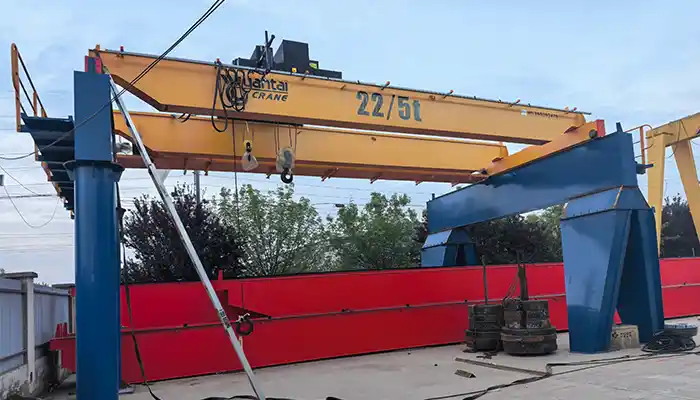
22/5 Ton Overhead Crane Double Hook System: Robust double girder crane with 22-ton main and 5-ton auxiliary hooks for heavy lifting. Get double hook crane!
Free consultation to Confirm Parameters & Specifications and Get
Latest Crane Price & Crane Rate.
- Types of overhead cranes : _______?
- Optional: Overhead travelling crane, goliath gantry crane,Slewing jib crane, Single girder or double girder crane,small portable crane or kbk crane, etc.
- Capacity of overhead crane: _______?
- Optional: 0.25ton, 0.5 ton, 1 ton, 2 ton, 3ton, 5 ton, 10 ton,15ton, 20ton, 25 ton, 30ton,35ton, up to 550ton, etc.
- Crane span & lifting height : _______?
- Crane travelling length : _____?
- Control of overhead crane:_______?
- Optional: pendant/ remote/cabin control
- Voltage supply of overhead crane:_____?
- Eg,: 380V50/60HZ,3Phase or others,etc.
- Application/usage of crane:_______?
- Eg,: Steel mill, ,injection mold, cement,stone, concrete,granite, general manufacturing, etc.
Just leave a message via the contact form and our hoist and crane engineer will contact you with in 24working hours.
Get In Touch
